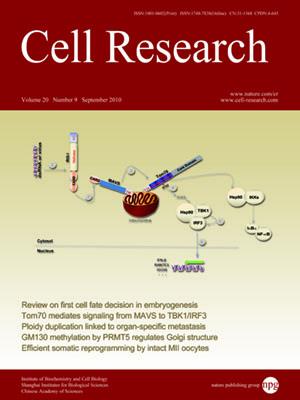
Volume 20, No 9, Sep 2010
ISSN: 1001-0602
EISSN: 1748-7838 2018
impact factor 17.848*
(Clarivate Analytics, 2019)
Volume 20 Issue 9, September 2010: 1034-1042
ORIGINAL ARTICLES
High-efficiency somatic reprogramming induced by intact MII oocytes
Hui Yang, Linyu Shi, Shenghua Zhang, Jiangwei Ling, Jing Jiang and Jinsong Li
Laboratory of Molecular Cell Biology, Institute of Biochemistry and Cell Biology, Shanghai Institutes for Biological Sciences, Chinese Academy of Sciences, 320 Yueyang Road, Shanghai 200031, China
Correspondence: Jinsong Li,(jsli@sibs.ac.cn)
Somatic nuclei can be reprogrammed into a pluripotent state by nuclear transfer, cell fusion and expression of transcription factors. However, these reprogramming processes are very inefficient, which has greatly hindered efforts to elucidate the underlying molecular mechanisms. Here, we report a new reprogramming strategy that combines the advantages of all three reprogramming methodologies into one process. We injected nuclei from cumulus cells into intact MII oocytes. Following activation, 80% of the reconstructed embryos developed to the blastocyst stage, and tetraploid (4N) embryonic stem (ES) cell lines were generated at a rate of 30% per reconstructed oocyte. We also generated triploid (3N) ES cells after injection of somatic nuclei into activated oocytes. 4N and 3N ES cells expressed pluripotent markers and differentiated into cell types of three embryonic germ layers in vivo. Moreover, all ES cells generated histocompatible, differentiated cells after being engrafted in immunocompetent B6D2F1 mice, showing that ES cells derived from this reprogramming strategy might serve as a source of genetically tailored tissues for transplantation. Thus, we have established a simple and highly efficient reprogramming procedure that provides a system for investigating the molecular mechanisms involved in somatic reprogramming.
Somatic nuclei can be reprogrammed into a pluripotent state by nuclear transfer, cell fusion and expression of transcription factors. However, these reprogramming processes are very inefficient, which has greatly hindered efforts to elucidate the underlyi
FULL TEXT | PDF
Browse 2336


